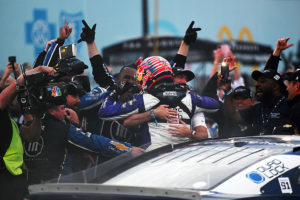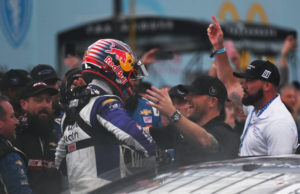By Seth Eggert, Associate Editor
Shane Van Gisbergen’s victory at the Chicago Street Course marked the first time in 50 years that a road course ringer captured the win in a NASCAR Cup Series race.

In the 50 years between Mark Donohue’s win at Riverside Int’l Raceway and Van Gisbergen’s history-making run at NASCAR’s first-ever street course race, many road course ringers have tried their hands at returning to victory lane. Ron Fellows, Tommy Kendall, Scott Pruett, Boris Said and Kimi Raikkonen are among the many road course ringers that have competed in the Cup Series.
Both Fellows and Said took wins in the NASCAR Craftsman Truck Series and Xfinity Series, but no road course ringer had reached victory lane in the Cup Series, until Van Gisbergen.
With the current NASCAR points system, the playoff structure and the emphasis on stages, the regulars in the Cup Series perfected their craft in recent years. Even before the Stage Era, Playoff Era or ‘The Chase,’ road courses proved more important as Jeff Gordon and Tony Stewart both took wins on the twists and turns of Sonoma Raceway and Watkins Glen Int’l.
The Cup Series regulars weren’t able to take the road courses for granted and swap in a ringer, though some teams lower in owner points did make that difficult decision, and still do in both the Craftsman Truck and Xfinity Series at times. The time of the road course ringer appeared to be over before the advent of the Next Gen car. Now, that may have changed as NASCAR and team owners look to put the sport more on a global stage.
The first glimpse of the revival of the one-off start by a road course specialist came with Raikkonen’s Cup debut at Watkins Glen. In the Trackhouse Project91 car, he shined, battling inside the Top 10 until contact on a restart sent him into the wall.
Factoring in Cup Series races now being held at Circuit of the of Americas (COTA), the Charlotte Motor Speedway ROVAL, the Indianapolis Motor Speedway Road Course, the Chicago Street Course and the old stalwarts – Watkins Glen and Sonoma, more of the world’s top drivers are seeing an opportunity to shine.
At COTA, the ringers like Jordan Taylor impressed in practice. Raikkonen and Jenson Button both ran well until the late-race chaos turned the EchoPark Automotive Grand Prix into a demolition derby. Being on the giving and receiving end of a bumper is shunned in other forms of international racing.
“I have respect in some ways in terms of how they drive, in terms of their speed and how they can place the car, their car placement, very impressive,” Button said post-race at COTA. “Some other things… a little bit disappointing. And, you know, it’s a tough one. It’s their way of racing, but when you’re not used to that, it’s tricky.”

On the streets of Chicago, Van Gisbergen’s victory proved a driver could get to the front without knocking someone out of the way. And that’s because the new Next Gen car is better-designed than the previous iterations of the Cup Series car. This nimbler car, which took inspiration from SuperCars and GT cars, is better suited to the road course ringers to come in and showcase their talent.
The main differences that still exist between the Next Gen car and SuperCars or GT cars now is the weight of the car compared to the GTs, the shifter, the lack of an actual door that opens, and the seating position for both. When the three-time Repco SuperCars champion won at Chicago, he sat on the opposite side of the car and was shifting with the opposite hand compared to the SuperCar he drives in Australia. That showed that the time to adapt to the new generation of stockcar is less compared to previous generations.
“Well the first thing is sitting on the other side of the car is tough,” Van Gisbergen said prior to his Cup Series debut at the Chicago Street Course. “And then climbing through the window. I’ve never done that before. It’s quite different. But the technical side of things is pretty similar in the way the car is built. A big, heavy car. A lot of horsepower. It’s similar to what we have. It looks difficult.
“When you watch the COTA race and how crazy that was, it was a bit eye-opening.”
As a result, the Verizon 200 at the IMS road course now has arguably the most road course ringers in competitive cars in recent memory. Button, the 2009 Formula One Champion, and IMSA Champion, Andy Lally, will be in the two Rick Ware Racing Ford Mustangs, which have been picking up speed over the past two seasons.
2021 24 Hours of Le Mans overall winner and two-time champion in the World Endurance Championship, Kamui Kobayashi, will make his NASCAR debut in a third 23XI Racing Toyota Camry.
Van Gisbergen returns to Project91 with fellow Repco SuperCars driver Brodie Kostecki making his Cup Series debut in a third Richard Childress Racing Chevrolet Camaro ZL1.
The road course ringers are making their presence known in NASCAR once more, potentially reopening the door to much more crossover from other racing disciplines in the future.